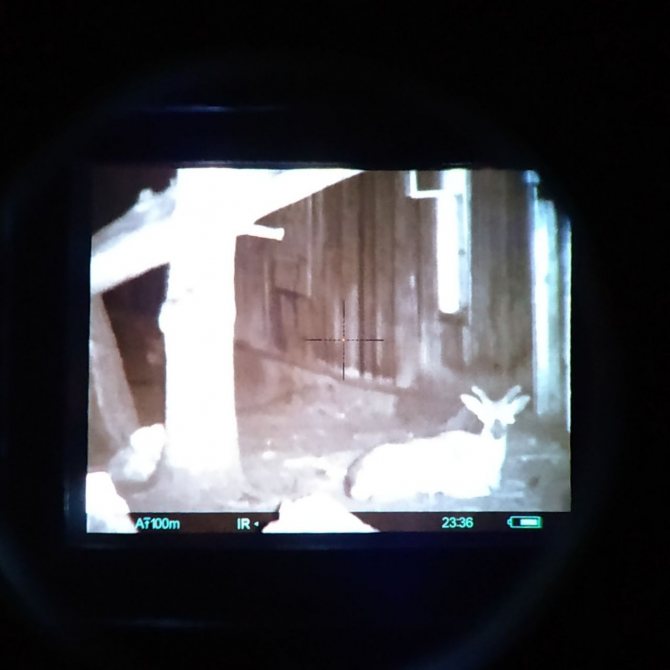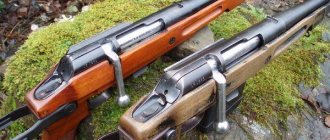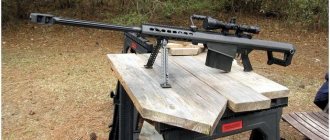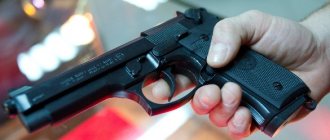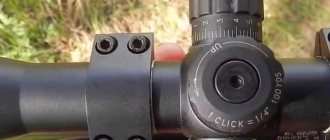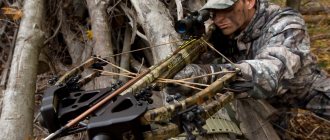Before choosing a sight for the Vepr carbine, let's figure out what kind of carbine there is and in what conditions you are going to use the sight. We will try to provide the necessary information for independent selection. And if this information is familiar to you, then simply select the type of sight according to the diagram, and then scroll to the end of the article to select the model of the sight.
Unlike its brother, the Saiga carbine, the Molot designers developed and launched into series a wide variety of Veprey models. The models differed in both the caliber of the cartridge, the length of the butt, and the height of the receiver - each model necessarily had something new. Often, changing the design entails the need to adjust the sight. For example, the folding stock on some models VPO-133 (Vepr-K) and VPO-136 (Vepr-KM) requires installation of a bracket on the barrel side - and only one bracket, the Weaver-Vepr 1B Base, can be installed in this way. The most important question when choosing a scope is the type of side rail installed.
Creation of a sight mount on Vepr carbines
Types of side planks
Three types of slats were installed on the Vepr, depending on the year of manufacture. When ordering monolithic sights with a bracket (optical or collimator), as well as side brackets, specify your type of rail in accordance with the sketch below:
However, on the weapon (especially if you are not the first owner), another bar can be installed, from Saiga:
or "Tiger":
, and may also not be installed at all. In this case, you will need to install one of the side bars (at the beginning of this list) yourself.
Weaver rail for the Vepr carbine
The Weaver rail (aka Picatinni) is convenient for installing monolithic red dot sights with a Weaver bracket or if your favorite sight is used on another gun with this rail. You can create such a footprint in three ways:
- adapter bracket from the side bar to Waever (for example, this one);
- the top strap on the receiver (it is necessary to drill the receiver);
- bracket for lightweight Rybka-AK collimators.
The common disadvantage of the last two methods is that, compared to the side bracket, the sight mounted on the top bar covers the open sight. This may not be as important in hunting as in combat. But there are times when an open sight may be needed: for example, if the animal came out close or quickly approached.
We have collected a complete list of brackets for Vepr carbines in this section of the catalog.
Preparation
The first step in zeroing an optical sight is preparing the weapon. This process should be approached with great responsibility, since the accuracy of the adjustment of the optical sight may depend on it. If even the slightest mistake is made, the bullet will fly past the target. Let's take as an example the Tiger carbine, which is quite famous among hunters.
Receiver height
We especially note that the side brackets for the Saiga and Vepr are higher than the brackets for the Tiger, since the latter have a lower receiver height. And since they always try to “plant” the sight as close to the receiver as possible in order to improve the “adjustability” of the weapon, the bracket (or a sight with a monolithic side bracket) from the “Tiger” and “SVD” for the “Vepr” will not fit even if you replace the side strip. However, the Veprey receiver is slightly lower than the Saiga and, for example, the PO 3-9x24 sight suits both of them. Still, before ordering a sight, we recommend checking the location of the side rail on the receiver (high or low) and checking it with the dimensions of the sight or bracket.
"Vepr-Pioneer": features of the carbine
This modification is in demand among buyers. Natural wood used in the manufacture of weapons looks aesthetically pleasing and is quite pleasant to the touch. The versatility of the “Pioneer” is that both men with large palms and teenagers can master shooting skills with it. Firearms are relevant in sports shooting, when accuracy and shot range are put first. An optical sight allows you to hunt medium and large animals, leaving them no chance to survive.
Advantages and disadvantages of Vepr-Pioneer
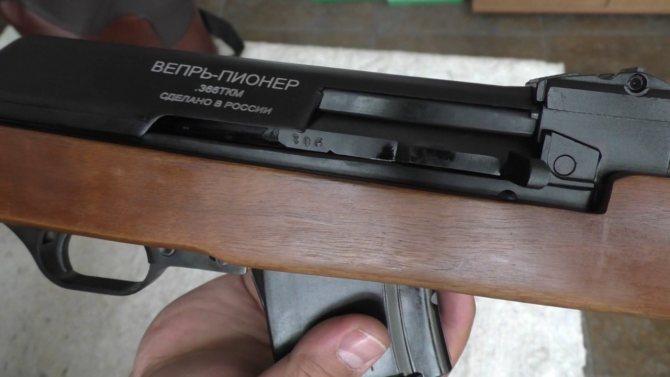
There are several basic parameters in which weapons are superior to analogues in the model range:
- modern appearance with attractive design;
- For natural wood finishing, beech or walnut are used. It is also treated with a special protective solution, due to which the weapon is resistant to low or high temperatures, field conditions, and areas with high humidity;
- simple design that makes it easy to assemble or disassemble the system.
One of the disadvantages that hunters report is the combination of the gas chamber and the front sight block. Despite the negative feedback about this nuance, this modification allows you to maintain optimal firing range.
Fundamental differences between the Pioneer carbine

The type of weapon was developed on the principle of the absence of complex mechanisms. The firing pattern is as follows: cartridges fly out as a result of pressing the trigger. To protect hunters from unplanned shots, the design provides for a push-button safety.
Upon purchase, the hunter receives a certificate and passport indicating all the technical characteristics of the product. This confirms its authenticity and legitimacy. The instructions indicate the rules for carbine care, operating features, and application technology.
It is also worth checking whether the name and manufacturer are indicated on the packaging. The basic kit assumes the presence of an optical system provided by the manufacturer. In the future, it is possible to replace it with a more advanced one, if there is a need to improve the accuracy of the shot.
How to choose a scope
As mentioned above, Vepr carbines differ primarily in the type and caliber of the cartridge used. From the point of view of the sighting device, it is important to distinguish cartridges according to their properties and the type of targets they hit:
- range;
- target size;
- accuracy.
By type of weapon (taking into account the features of the “Boar”) you will get the following plate:
| Chuck type | Range | Target size | Accuracy | Aim |
| Smoothbore (shot) | small | small | Not important | Collimator |
| Smoothbore (bullet) | small and medium | large | Important | Collimator or Chaser |
| Small caliber | small and medium | small | Important | Optical (Mil Dot) |
| Intermediate and rifle cartridge | middle and long | medium and large | Important | — Enclosure, — small constant multiplicity, — large variable multiplicity |
Smoothbore "Vepr", hunting with shot
The shot is characterized by a large affected area and a short firing distance, the size of the target is usually small (even when shooting with buckshot), and the speed of the target is the opposite. Hunting is often carried out on a bird “flying” and a running hare. A wide field of view is important here, which allows you to quickly locate the target through the sight. This is why many hunters never use a scope, but instead aim along the line of the barrel. Still, a collimator sight will increase your chances of catching game. It is important to choose the correct size of the aiming point - depending on the accuracy and the likely distance to the target. For shotguns, the aiming point size usually starts at 3 MOA. But for greater versatility (with a bullet), we recommend considering sights with interchangeable reticles. More details about choosing a collimator for smooth-bore weapons can be found in this article.
Smoothbore "Vepr", hunting with a bullet
Even the most accurate bullet and a “conditionally smooth-bore” Lancaster allow a shot distance of no more than 150 meters, and in real hunting from a smooth-bore “Vepr” the distance does not exceed 70..100 meters. Hunting with a heavy 12-gauge bullet is usually carried out on large animals, such as wild boar or elk. Therefore, there is no need to chase a large increase. If a single red dot sight is not enough (for example, if you have poor eyesight and need diopter adjustment), then an optical sight up to 4 times will be enough with a margin. Classic PSO-1 sights, as well as their Novosibirsk analogues PO 4x24 (Vepr), do not have diopter adjustment; snipers have no need for it. But the Belarusian plant Belomo, one of the manufacturers of PSO-1, produces similar civilian POSP sights with diopter adjustment.
Optical sights, which combine the advantages of both collimators and optical sights, have a magnification of 1 to 4 times. Traditionally, they are called “drivers” and are used accordingly in driven hunts. You can read about choosing such a sight in this article, and a complete list of them has been collected in this section of the catalog. They are installed on the Weaver top or side bracket, as described above.
Small-caliber "Vepr"
The small bullet is distinguished by its low bullet weight, but its high accuracy. The target size is also small. And the deflection of the bullet greatly depends on the firing distance. If you are planning hunting or sporting and recreational shooting at targets at short distances, at which there is no need to take into account bullet drop, then you can opt for any optical sight up to 4x.
But often with small-caliber rifles they hunt a cautious bird that does not let the hunter get close. Then you should pay attention to high magnification scopes with a Mil Dot or similar reticle with the ability to make ballistic corrections.
Variable magnification sights will be a little more versatile. Here it is worth paying attention to the fact that the sight reticle is in the first focal plane, that is, it increases with increasing magnification. Otherwise, the ballistic reticle will only work at one magnification. A good example of such a scope is the PO 3-9x24. However, from other manufacturers (for example, Japanese Nikon) you can select more suitable models, but without a side bracket. We talk in detail about choosing a sight for small animals in this article.
"Vepr" caliber 7.62
The largest number of Vepr models were produced in 7.62 caliber, primarily due to the continuity of the Kalashnikov, as well as the variety of cartridges of this caliber. The variety of cartridge power and bullet accuracy entails a variety of game caught, but usually it is a medium or large-sized animal. If you know the type of hunting and the animal that you most often hunt (or will hunt), then it will not be difficult to select a suitable scope using the recommendations described above for other calibers. Here we just note once again that
- The classic military version of the optical sight on the AK is the PSO-1 sight adapted from the SVD (hunting with it is prohibited in Russia), and its civilian successor is the PO 4x24 (Vepr). Read more about this sight and its analogues in this article.
- The armed forces of many countries around the world are equipped with collimator sights from the Novosibirsk plant. Exactly the same sights are entering civilian use.
Let’s also pay attention to the versatility of driven sights with variable magnification.
Muzzle energy of cartridge
An important parameter of the sight is the shock resistance to the recoil of the weapon. This parameter directly depends on the power of the cartridge used. All side-mounted optical sights recommended above (civilian models PSO-1), such as POSP or NPZ-shniye PO, can withstand any weapon recoil - they were developed taking into account the experience of producing sights for combat operations. Most sights, including even inexpensive Chinese-made sights, can withstand the impact of any rifled Boar caliber. But if you are trying to install optics on a smooth-bore weapon, choose time-tested brands.
Due to the simplicity of their design, red dot sights can usually withstand powerful recoil. But you should avoid unknown Chinese brands, especially when ordering them from Chinese marketplaces, which are not subject to Russian consumer protection laws. We've seen scopes that literally shatter into parts after just a few shots.
Until recently, it was especially important to take shock load into account when choosing a night vision scope: not all scopes with generation 1 and 1+ image intensifier tubes could withstand the recoil of powerful weapons. And since the Vepr, especially on the secondary market, is considered a fairly budget weapon, in this regard, the desire of its owner to install an inexpensive sight is understandable. Currently, digital sights have completely replaced sights of the 1st and 1+ generations of image intensifier tubes from the market, and their design, which eliminates the fragile bulb of the image intensifier tube, can withstand the recoil of any civilian caliber. They are the most modern night vision devices and you can safely choose any of them for any Vepr carbine, regardless of caliber. Most of these sights, when using IR illumination, allow you to hunt at distances of up to 150 meters. Read more about how to choose them here about a digital imager, and here about a thermal imager.
At the same time, sights with image intensifier tubes of older generations have their advantages: much longer operation on a single battery and a reliable design that eliminates complex microcircuits and software. The “Vepr” with a rifle cartridge (7.62x51 or 7.62x54 and their varieties) is not inferior in sighting distance to the sniper “SVD”, so it is more advisable to install on it a civilian analogue of the 1PN93 - PN23 “Saracen” sniper scope or one that is not inferior to it in quality, range and shock resistance Dedal-460-DK-3 BW. These scopes will allow you to hunt up to 300 meters.
Preparing to zero the carbine
The most popular among us are inexpensive Russian weapons, both rifled and smooth-bore. When purchasing it, you need certain knowledge, since the percentage of substandard products is quite large. This also applies to cartridges, especially for rifled weapons. The main part of a rifled carbine is undoubtedly the barrel, on the quality of which its combat primarily depends. Now there is a fashion for forged barrels, which are considered almost ideal. There is no need to focus too much on technological processes - this is a matter for manufacturers. We are interested in the final result.
Let's start with the most common caliber among hunters, 7.62 mm, or 300, 308 - these are just different designations for the same thing. For Russian hunting carbines of this caliber, the barrel diameter along the rifling fields should be 7.62 mm, and along the rifling - 7.92. The bullet diameter of Russian cartridges is 7.78-7.92, which can create some problems. The first thing the buyer should do is, using a very accurate bore gauge, measure the diameters of the barrel, both by rifling and by margin. For a number of reasons, they can have significant deviations, and therefore the same carbines can give completely different combat.
- Knowing the carbine barrel diameters will help you choose cartridges for it. Russian ammunition in most cases is suitable for “native” weapons, although often they do not give consistent shooting results from batch to batch. Western-made cartridges have a bullet diameter along the rifling that does not exceed 7.83 mm, which is why they are of little use for Russian barrels. Therefore, you can hear how a hunter is indignant at such cartridges when they give worse accuracy than Russian ones. True, practice shows that among Russian trunks there are defects when some of them are narrowed. Western-made cartridges are quite suitable for this, providing good accuracy of combat. When you check this parameter during zeroing, you need to know what can be achieved from this or that sample. For example, from a 5.6×39 caliber Bars carbine, you can place bullets in a circle with a diameter of 7.5 cm at a shooting distance of 100 m. The KO-44 carbine provides a shooting accuracy of 20 cm, the Los-1 9 mm caliber – 11 cm, OP-SKS – 20 cm, “Argali”, created on the basis of SKS, – 20 cm.
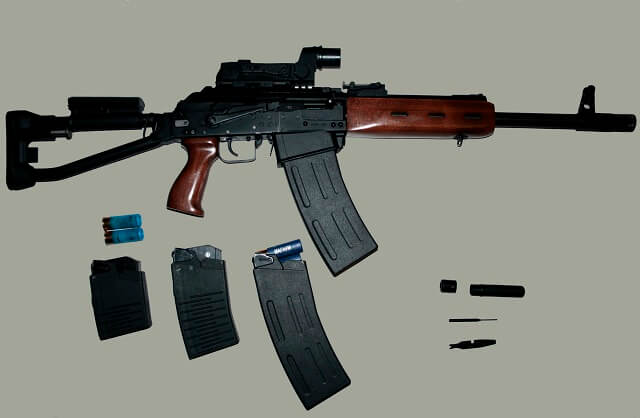
Saiga carbine
Please note that the use of Western cartridges may be unsafe for the shooter. In Russian-made barrels, some of them can develop very high pressure, for which the barrels are not designed. When buying imported cartridges, you need to accurately find out all its parameters.
If a carbine does not give a stable fight, that is, the point of average impact changes from shot to shot or from one batch of shots to another, then you cannot accept this. First of all, you need to try to choose a cartridge that best suits your barrel. When this fails, you need to look for the cause in the optical sight or its mount.
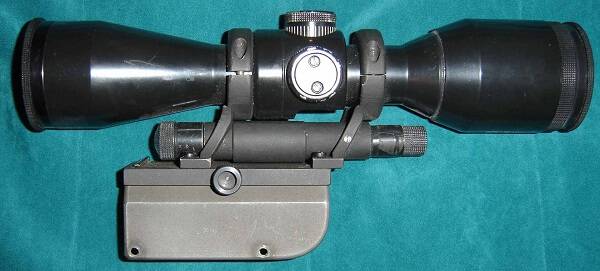
Bracket for mounting optics
The best bracket for mounting optics is a steel, non-removable one. The price of a good removable bracket may exceed the cost of a carbine. A stationary bracket can be easily manufactured on any jig boring machine from HVG steel without subsequent heat treatment. This steel has a small coefficient of linear expansion and, even without heat treatment, has sufficient strength, which allows you to make the bracket elegant and lightweight. Suitable for the bracket is 5ХНМ steel, which also does not require heat treatment.
The weak point of mounting optics is the threaded connections. In no case should the threads break off on the bracket, only on the bolts, which in extreme cases can be replaced - it is best to make them from 45 or 40X steel. In places where the optics bracket wraps, strong clamping is unacceptable: this can damage the scope body. In these places, you need to create a roughness on the surface of both the optics and the bracket and place the bracket on epoxy resin with the addition of the required amount of plasticizer. Such brackets must be attached to the weapon very securely, tightening the bolts thoroughly.
It’s not bad if you manage to find a good ready-made bracket, but not made of aluminum alloys. The latter is acceptable only for the 22LR cartridge - small-caliber.
If, with a high-quality mount, you still cannot zero the carbine, then you need to get to the optics. Now a machine for zeroing weapons wouldn't hurt. If there is none, try securing your weapon through rubber or felt pads in a vice or other device. Having aimed the crosshair of the sight at some small object and firmly fixed the weapon, you need to hit the optical sight with a rubber or polyurethane hammer for straightening cars and see if the aiming mark has gone astray from the target. Its shift indicates that it is time to start disassembling the optics without disturbing the lens fitment, so as not to misalign them. Most likely, you will find that the cause of the defect was insufficiently tightened bolts or play in the system for adjusting the optics horizontally and vertically. You can seek help from a specialist or the factory, although in these cases it will take a long time. In any case, it’s worth starting with repairs. After all, almost all domestic optics either do not “hold” the adjustment right away, or quickly go astray - after 50-70 shots.
Cheap imported optics, which our hunters love to buy, behave in exactly the same way. I would still advise buying Russian or Belarusian sights, as they are easier to disassemble and reassemble. In addition, among the imported ones there may be ones made in an unknown place.
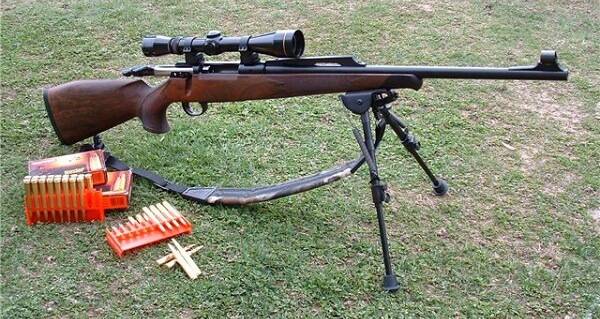
Shooting a hunting rifle
Depending on the type of hunt
Now let’s take a closer look at the main types of hunting and how the type of hunting and the game being caught affects the choice of a scope for Vepr carbines.
Driven hunt
Driven hunting is a collective hunt, so in addition to adrenaline, the hunter receives pleasant communication among like-minded people. The main difference between driven hunting and other types is that hunters are divided into two groups - beaters (they drive the animal to the shooting line) and hunters waiting for the animal in ambush - shooters. When hunting with a drive, a beater (usually one or two) drives the game towards the shooters so that the animal is visible to all participants in the hunt (each shooter has a specific place with a number where he should wait for the animal). During a driven hunt, shooters can be on towers; such hunting is called combined.
Sit-down
Unlike the driven method, the hunter, as a rule, goes alone to ambush. The hunter chooses the most suitable place and waits for the animal. The most important factors leading to success are the correct equipment, shelter and suitable wind. The most suitable place for ambush is when the animal does not see the hunter, and he, in turn, has an excellent view. A place on the hide must be taken at least an hour and a half before the animal goes out to graze, so that the smell of the tracks goes away (since animals have a very good sense of smell) and to disguise it. When in hiding, you must remain motionless so as not to detect your presence. This type of hunting will be interesting to a hunter who enjoys painstaking preparations and unity with nature.
Shooting "on the fly"
When shooting at the side, the hunter does not shoot at a moving target, but slightly ahead of it, where, according to his calculations, the target will meet the flying projectile. From the outside it may seem that the hunter, without thinking, raised his gun on his shoulder, fired and hit the target. But this is a deep misconception, in fact, a complex process takes place in the shooter’s head, which includes: target detection, target position, the distance at which it is removed, the speed and direction of its movement, the magnitude of the correction when firing is determined, then it takes the position “at ready”, places the gun to his shoulder, takes aim, smoothly moves the body with the gun in the direction of the target’s movement and then fires a shot. This action happens instantly, and it will be quite difficult for a beginner to cope with such a task. The position of the gun is determined in two ways: either the hunter rests the butt against his shoulder in advance or holds the gun with the butt lowered below the armpit and, when game appears, throws himself onto his shoulder.
Reviews of the Vepr 308 carbine
The most important advantage of the Vepr-308 carbine, and the entire family of Vepr carbines, is its high reliability and quality. This carbine's automation is built and operates on the principle of a Kalashnikov assault rifle, and this is one of the most reliable systems in the world. Therefore, any carbine of this family, and in particular the Vepr-308, is capable of serving for several decades and never letting its owner down. The next advantage is the accuracy and accuracy of the shot.
The Vepr-308 hunting carbine confidently hits the target at a distance of 50 to 450 meters
At the same time, the spread of bullets is very small. When installing an optical sight, shooting efficiency increases several times. The Vepr-308 carbine has a relatively light weight, which is very convenient when traveling on foot during hunting. Also, this carbine has the ability to be independently upgraded, that is, the owner himself can install the optics that he likes best. You can also choose a magazine: five or ten rounds. The cost of this carbine is relatively low compared to similar automatic carbines, which can also be considered an advantage. One of the disadvantages is that the optics are not installed normally, so when installing it you have to carry out shooting and adjustment.
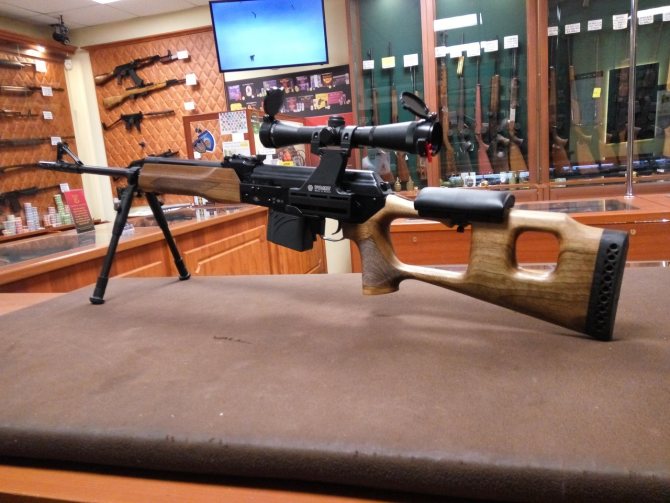
Rating of sights
Vepr carbines come in smoothbore 12 gauge and rifled 7.62x39 (old style), 7.62x51 (.308Win) is the main caliber, as well as 7.62x54 (rare). For these models, you must use sights that can withstand a muzzle energy of at least 4,000 J. For other calibers, the recoil requirement is not so significant.
Night sights
“Vepr” is an inexpensive weapon, so it is natural for hunters to want to save money on a night vision scope. The most budget option that can withstand the recoil of any cartridge at the moment is the Yukon Sightline N455S night vision scope. It provides visibility of up to 150 meters, which is suitable for night hunting - since in Russia only night hunting from a tower is currently allowed.
But, if your budget allows, we recommend considering installing a digital sight. The “diseases” of the first digital cameras, such as a small viewing angle and poor resistance to frost, have been overcome in new sights, for example, the Pulsar Digex N455 sight or the ATN X-Sight II HD 3-14x. At the same time, the image quality at short distances (up to 150 meters) is better than in night sights with third-generation image intensifier tubes. Additionally, the software of these sights allows you to sight it with one cartridge, change reticles and other additional options.
The Pulsar Digisight N455 LRF equipped with a laser rangefinder is also perfect. Knowing the maximum permissible distance of your gun and bullet, this digital sight will easily help you determine the distance to the target and make the necessary adjustments “on the fly.” For example:
- You can prevent an early shot by using a smoothbore weapon by letting the animal get closer.
- At a distance of up to 300 meters, using a rifled carbine, deliver an accurate shot.
Comparison of the image of a digital sight with a 3rd generation image intensifier sight
| |
| PN-23 "Saracen" with image intensifier of the 3rd generation. (B/W) | Yukon SightLine N455 |
Sights of the second and third generations are more reliable, unpretentious and have a longer battery life.
- Night sight PN23 "Saracen" with image intensifier 2+
- Night vision scope Dedal-460-DK-3 BW
they provide a greater shooting distance, and smooth barrels have a much shorter aimed shot distance, about six to eight times.
When hunting during daylight hours, optical and collimator sights are used.
How to zero a weapon
I recorded a detailed video about shooting a boar with a 12 hammer, be sure to watch it, since you can’t cover everything in the text.
Preparation
So: we fix the plywood on the tree, attach the target with tape to the plywood. We retreat to a distance of 35 meters (the distance is indicated on each target).
Shooting
At first you can fire 2-3 shots. I aimed at the bottom of the target first, in case the gun “got high” and at the center.
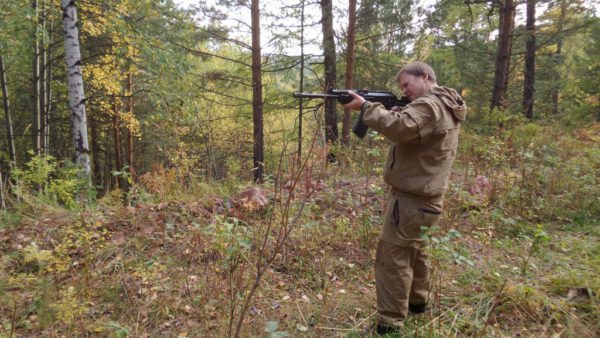
Conclusions after the shooting
Then you need to approach the target and see where the bullets hit. Based on the inspection, we can draw certain conclusions: if you were aiming at the center, and all the bullets landed higher and to the right, then you need to unscrew the front sight and move the aiming bar to the right. If the bullets land lower, then you need to raise the aiming bar.
How much you need to raise the front sight or aiming bar can be determined experimentally. Using my own example, I can say that the bullets rose an average of 15-20 cm. I unscrewed the front sight by about 2 turns. After adjusting the sighting devices, take a few more shots and, based on the inspection, make the appropriate adjustments to the front sight and sighting bar. Continue this way until the result of the hit satisfies you.
